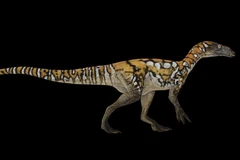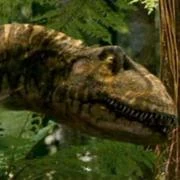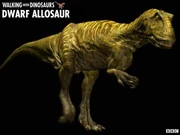| Australovenator Temporal range: Late Cretaceous (95 Mya) | |
|---|---|

| |
| A restoration of Australovenator wintonensis | |
| Scientific classification | |
| Kingdom: | Animalia |
| Phylum: | Chordata |
| Class: | Sauropsida |
| clade: | Dinosauria |
| Superorder: | Theropoda |
| Genus: | †Australovenator Hocknull et al., 2009 |
| Species: | †A. wintonensis |
| Binomial name | |
| †Australovenator wintonensis Hocknull et al., 2009 | |
Australovenator (meaning “southern hunter”) is a genus of megaraptoran theropod dinosaur from late Albian (Early Cretaceous)-age rocks of Australia, belonging to the Megaraptora.

Australovenator Skeleton
It is known from partial cranial and postcranial remains.
Description and history[]
Australovenator is based on AODL 604 (affectionately named “Banjo”) a partial skeleton including a left dentary, teeth, partial forelimbs and hindlimbs, a partial right ilium, ribs, and gastralia. Australovenator was described in 2009 by Scott Hocknull and colleagues.
Paleobiology[]
AODL 604 was found about 60 kilometres (37 mi) northwest of Winton, near Elderslie Station. It was recovered from the lower part of the Winton Formation, dated to the latest Albian. AODL 604 was found in a clay layer between sandstone layers, interpreted as an oxbow lake, or billabong, deposit. Also found at the site were the type specimen of the sauropod Diamantinasaurus, bivalves, fish, turtles, crocodilians, and plant fossils. The Winton Formation had a faunal assemblage including bivalves, gastropods, insects, the lungfish Neoceratodus, turtles, the crocodilian Isisfordia, pterosaurs, and several types of dinosaurs, such as the sauropods Diamantinasaurus and Wintonotitan, and unnamed ankylosaurians and hypsilophodonts. Plants known from the formation include ferns, ginkgoes, gymnosperms, and angiosperms.

Australovenator was a medium-sized megaraptoran. According to Hocknull, it was 2 metres (6.6 feet) tall at the hip and 6 metres (20 feet) long. Only a single individual has been uncovered so scientists can't be certain if the skeleton is an adult or juvenile. Because it was a lightweight predator, he coined it as the “cheetah of its time”. Like other theropods, Australovenator would have been a bipedal carnivore.
In the Media[]
Australovenator made an appearance in the famous documentary Walking with Dinosaurs (however, it was called "Dwarf Allosaur" because scientists hadn't come up with a name for it yet, and the animal in the series was based off the Cape Paterson Claw that was discovered in 1903 [1]), where it attacked a small herd of Leaellynasaura and killed its female matriarch. It also harassed a herd of the large iguanodont Muttaburrasaurus and scavenged a carcass from one of them.

Walking with Dinosaurs Allosaur (inaccurately identified as Australovenator)
The Australovenator nicknamed 'Banjo' appears in both fossil and live form in the documentary Australia: The First 4.5 Billion Years/Australia: The Time Traveler's Guide, Dino Stampede and Monsters of the Outback. The Australovenator is availale as a playable dinosaur in the video game Pangea Survival.

Australovenator from Australia: The First 4.5 Billion Years.

Australovenator in Monsters in the Outback